Maratha Mandir Marg was earlier Club Road, at Bombay Central, named for Byculla Club, the city's first residential club in 1834.

Maratha Mandir
 Aao, aao, aao…" the husky chant reaches me from the auditorium door briefly ajar for an usher exiting. Other employees of Maratha Mandir solicitously assure I will soon meet the theatre's executive director, Manoj Desai. Meanwhile, I'm fascinated to explore the various foyer levels of a theatre with decidedly more distinguished interiors than its bland facade.
Aao, aao, aao…" the husky chant reaches me from the auditorium door briefly ajar for an usher exiting. Other employees of Maratha Mandir solicitously assure I will soon meet the theatre's executive director, Manoj Desai. Meanwhile, I'm fascinated to explore the various foyer levels of a theatre with decidedly more distinguished interiors than its bland facade.
Unravelling inside, the matinee to beat all matinees ticketed averaging an affordable 20 bucks, flashes the pigeon feeding scene of Dilwale Dulhania Le Jayenge, in its unprecedented 25th year. It was an impromptu sequence. Reporting on Aditya Chopra's set ahead of Amrish Puri, SRK started to scatter grain for the birds. Puri came, adding the gravelly "Aao". An earlier Chopra family link here was BR Chopra's Sadhna, inaugurating Maratha Mandir in 1958.
The theatre hugs a corner address, unrecognisably once among Bombay's poshest. Maratha Mandir Marg was Club Road and Club Back Road was subsequently marked by the YMCA. Skirting Lamington Road to Morland Road (present site of the Mumbai Bagh protests), it embraced the wide north flank of elite Byculla Club, the city's first residential club in 1834.
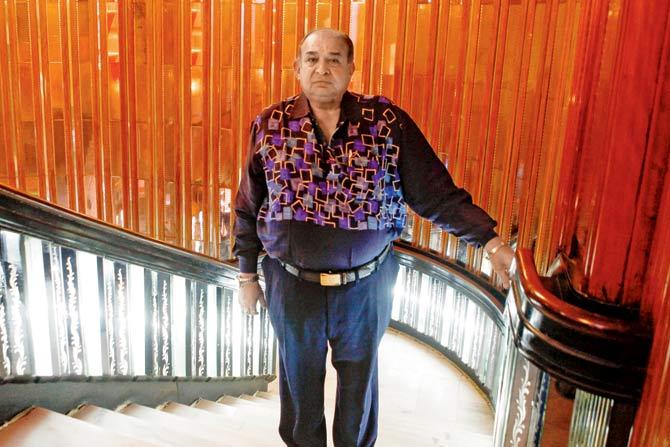 Manoj Desai, executive director of Maratha Mandir theatre, in the Belgian glass-panelled interior of the 1958-built cinema that creates history this year, screening Dilwale Dulhania Le Jayenge for 25 consecutive years since its release. The interiors are resplendent with the Art Deco ceiling and wall flourishes along the grand staircase.
Manoj Desai, executive director of Maratha Mandir theatre, in the Belgian glass-panelled interior of the 1958-built cinema that creates history this year, screening Dilwale Dulhania Le Jayenge for 25 consecutive years since its release. The interiors are resplendent with the Art Deco ceiling and wall flourishes along the grand staircase.
"Indians were prohibited in numerous British clubs. Foremost were the Byculla Club and Yacht Club," writes Advocate Abhinav Chandrachud in An Independent, Colonial Judiciary: A History of the Bombay High Court During the British Raj: 1862-1947. Those discriminatory clubs were classist and sexist too—"The Yacht was a social Mecca, membership to it for a European meant he had socially arrived. The Byculla Club was for men only, useful when 'a man wanted to get away from his wife'."
Rejecting racial segregation, two rival clubs were established for Indians and Europeans. "Founded at the turn of the 20th century by Chief Justice Lawrence Jenkins, with others, the Orient Club was the oldest such in India," Chandrachud continues. "Willingdon Sports Club was set up towards the end of the First World War by the Governor of Bombay, Lord Willingdon because he had a direct mandate from the Secretary of State to do away with the 'damning racial exclusiveness' of European clubs in Bombay."
Sir Stanley Reed recounted how, following the introduction of electricity in town, Byculla Club members "fought against the barbarism of fans in the dining room and when you sat, in came a hamaal with the traditional fan on a six-foot pole, swaying it to and fro behind you at meals." The vast premises eventually closed after World War II.
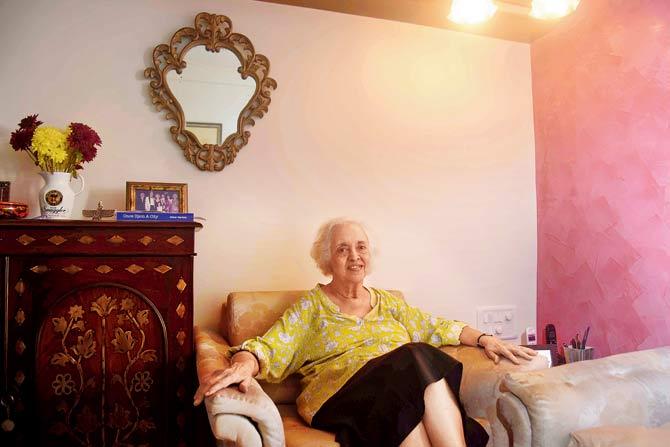 Mehroo Golvala, nee Khambatta, in her Pedder Road home. The 1930s resident of Club Road has vivid memories of the lush garden of their Shirin Villa home. The bungalow once belonged to timber merchants. Pics/ Atul Kamble
Mehroo Golvala, nee Khambatta, in her Pedder Road home. The 1930s resident of Club Road has vivid memories of the lush garden of their Shirin Villa home. The bungalow once belonged to timber merchants. Pics/ Atul Kamble
"Our initial 1930s years were inseparable from Byculla Club," recalls Mehroo Golvala, nee Khambatta. "It occupied a sprawling block with its own stables and hosted grand dance balls. We walked casually to its grounds for games of 7 Tiles and I Spy." The green canopy thickened with the road's raintrees, palms and ashokas. In her Number 10, Club Road garden grew honeysuckle vines and colourful cannas. On a pretty profusion of crepe jasmine flowers crawled caterpillars that kids caught and cared for in boxes with lid holes allowing air, till they transformed to butterflies set free. Trees hung heavy with mangoes, drumsticks, papayas, elaichi bananas. And methi so tender tasting that, plucked fresh to form a base layered over with fried eggs, resulted in "the best 'bhaji per eedu' for miles". The Parsi penchant for eggs over veggies is a standard culinary delight.
The Khambattas of Shirin Villa had memorable musician neighbours in Hetty and Wilfred Fernandes in Meher Villa from 1954. Hetty's internationally renowned pianist daughter, Marialena, writes from the University of Music and Performing Arts, Vienna: "Byculla Club was extremely colonial, stately on a street with hardly any traffic. It stared down on the street habitants, almost artificial for us children starved for noise, laughter, spontaneous fun.
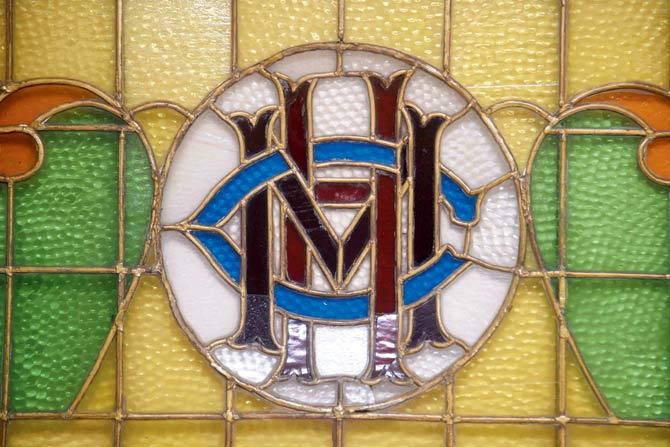 A stained glass window with the family crest initials of the Colahs who lived at 8, Club Road. From their balcony they clearly saw the Bombay Central Station clock across open maidan stretches and could hear the zoo animals of Rani Baug
A stained glass window with the family crest initials of the Colahs who lived at 8, Club Road. From their balcony they clearly saw the Bombay Central Station clock across open maidan stretches and could hear the zoo animals of Rani Baug
"My mother had a voice not only beautifully inspiring but capable of soothing the disturbed. According to her, I played piano before I spoke. She encouraged me to keep up my talent, to the irritation of my siblings who preferred cricket on Club Cross Road where the Seventh Day Adventist Church still stands. It was even more British than the British, with daily evening ceremonial service, perfectly harmonious choir and representative congregation. In a mixture of mischief and cheap thrill, we peeped through our barricaded windows and front gate, with lights off, so they couldn't see us. Thanks to mom's friendliness, an American Adventist family sold us the first marimba (a percussion instrument of wooden panels on metal pipes, hit with mallets held in both hands) seen in India."
That became the entertaining highlight at their parties, Marialena remembers—"Mom at the piano, me on the marimba, our guests singing loud. People dropped by, joining the community singing in different languages. My mother put us all in the mood and accompanied everything, so great was her ear. My sister Joanne and I sang with her as a trio known as Wilf's Wonderful Women. Dad was Wilfred. A major part of my life, Club Road holds a special place in my heart."
A friend of Marialena's brother Andrew in their schoolboy days, executive search consultant Ramgopal Rao spent his childhood in the iconic RBI Staff Colony across the road. The Raos shifted into the horseshoe-shaped complex's new "M" Block four summers after 1954, when, at the initiative of Sir CD Deshmukh, the first Indian RBI Governor, these quarters rose with the best amenities. "The society was fantastically self-contained, with a medical dispensary, provision store, Irani stall selling cakes and a basement badminton court where the likes of Nandu Natekar came to play," says Rao. The colony was conceived in a utilitarian, civic-minded manner. For instance, chutes from the topmost floors slid garbage smoothly into wheelbarrows waiting below."
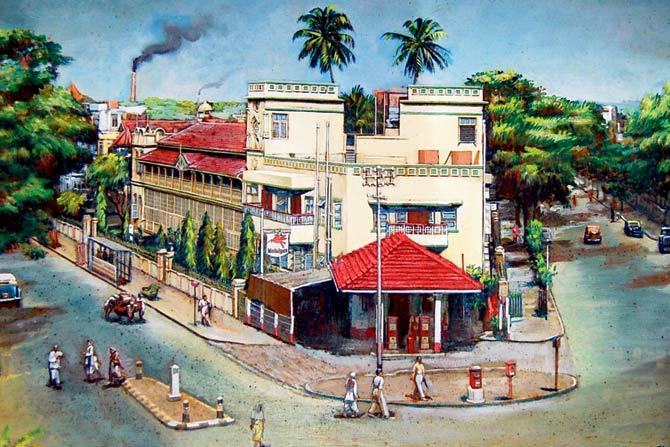 A painting of the landmark Byculla Nursing Home, made famous by Dr Stanislaus Patrao. Signed by the artist Trivedi, it wonderfully captures the precinct’s peace and quiet. The Patraos were actually able to see the Trombay gas flares and even flames, so unobstructed were the views all around.
A painting of the landmark Byculla Nursing Home, made famous by Dr Stanislaus Patrao. Signed by the artist Trivedi, it wonderfully captures the precinct’s peace and quiet. The Patraos were actually able to see the Trombay gas flares and even flames, so unobstructed were the views all around.
A lane-off landmark is Dr Stanislaus Patrao's now dilapidated Byculla Nursing Home, shuttered 15 years ago. The good doctor, Grant Medical College's sole student holding a triple graduate qualification in Medicine and Surgery, was awarded the degree in the Department of Anatomy and Embryology, a First Class with Distinction. Purchasing the property in the 1940s, he shifted his hospital in 1955 from Morland Road to this largely wooden structure with jack arched roofs crowning 18-feet-high ceilings. Once the King's Lodge hotel, the layout was well suited for a hospital, the central lobby and rooms with attached bathrooms on either side, a garage and workers' rooms at the rear.
Where the road behind this nursing home—Souter Street (Meghraj Sethi Marg)—forks, Motlibai Street on the left brings me to Terrace View. Stepping into Soraya and Fabia Postel's penthouse Airbnb atop Noon Baker Apartments reveals uncommon charm. The sprightly mother and daughter lead me to the patio commanding a spectacular east-facing panorama of Baby Garden, Gloria Church and gleaming white Hasnabad dargah, considered the city's Taj Mahal. The Postels' location lets travellers connect within minutes to the bus depot and three stations of Bombay Central, Mahalaxmi and Byculla. "Throwing open our home has been life-changing and given me economic independence," says Soraya. "I have it in me to be welcoming. My parents would always greet me with the warmest smiles at our door."
Not resisting smoked mince samosas from an aromatic kitchen, I bask in the women's effervescent hospitality. A single mother and French teacher, Soraya is as passionate about taking guests on unusual customised "experiences". This week, her Supermen of the City tour has guided a group to understand the vital contribution of ragpickers, cleaners and washermen.
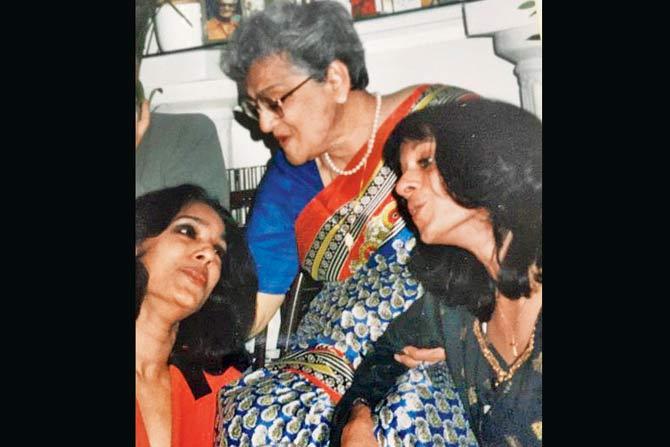 A late 1980s photograph of pianist Marialena Fernandes (in red) with her mother Hetty and sister Joanne, the famous singing trio of Meher Villa, 14 Club Road. Pic courtesy Marialena Fernandes
A late 1980s photograph of pianist Marialena Fernandes (in red) with her mother Hetty and sister Joanne, the famous singing trio of Meher Villa, 14 Club Road. Pic courtesy Marialena Fernandes
Desis and foreigners post a flood of reviews: "Ending an incredible 80-day journey throughout India—this oasis is the best lodging of my entire trip" and "I was nervous finding my correct train. They actually walked me to the platform and came aboard to make sure." Touched by them driving her to a mango vendor when she mentioned her mother loves the fruit, a Baltimorean looks forward "to be back to my new home in Mumbai".
Passing by a young swain softly murmur the achingly romantic "Palat ke dekhegi" dialogue, I finally enter Manoj Desai's office, crammed with jubilee trophies that celebrated blockbuster hits including Kabhi Kabhie, Mr India, Amir Garib and Coolie. Desai, also executive director of Bandra's G7 Multiplex, reels off real-life dramatic moments. Dilip Kumar rode a horse to K Asif's glittering premiere of Mughal-e-Azam at Maratha Mandir on August 5, 1960. Madhubala shone, vision-like, in a palanquin. The print arrived on festooned elephants.
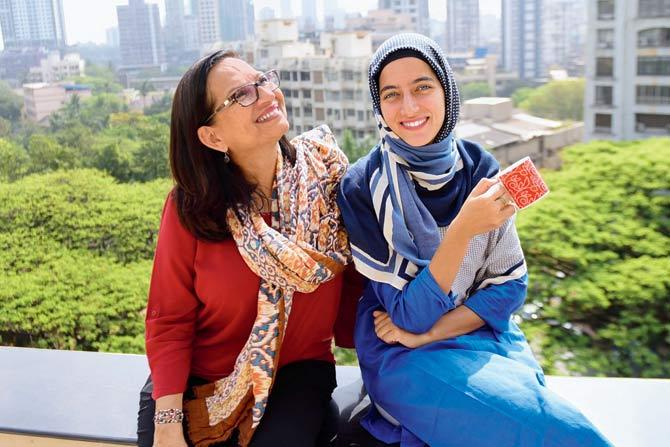 Soraya Postel with her daughter Fabia on the sprawling terrace of the cosy Airbnb they run on neighbouring Motlibai Street. Pic/ Bipin Kokate
Soraya Postel with her daughter Fabia on the sprawling terrace of the cosy Airbnb they run on neighbouring Motlibai Street. Pic/ Bipin Kokate
"Paying cheap prices, labourers from the area are able to relax for three hours with air-conditioned comfort and clean toilets," reasons Desai. "People make plans around DDLJ. Passengers boarding evening trains to Gujarat schedule time to catch our 11.30-2.30 show. Couples who dated here return bringing their children to watch the same. This phenomenon is like no other anywhere."
Imbibing much lively movie lore, I ready to leave. It's the hour of Tapsee Pannu acing the nuanced Thappad. But the craze for one film alone seems seeped into the very walls of this hall. "Come fall in love", the tagline invites. I hail a cab. Whose driver promptly asks, "Kitni baar dekha hain yeh picture aapne?"
Author-publisher Meher Marfatia writes fortnightly on everything that makes her love Mumbai and adore Bombay. Reach her at meher.marfatia@mid-day.com/www.mehermarfatia.com
Catch up on all the latest Mumbai news, crime news, current affairs, and also a complete guide on Mumbai from food to things to do and events across the city here. Also download the new mid-day Android and iOS apps to get latest updates
 Subscribe today by clicking the link and stay updated with the latest news!" Click here!
Subscribe today by clicking the link and stay updated with the latest news!" Click here!









